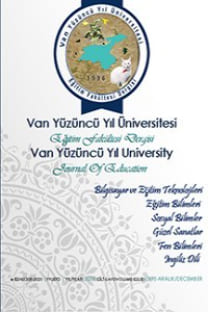Kişisel Anlam Profili Kısa Formu (KAP-KF): Türkçe Geçerlik ve Güvenirlik Çalışması
Kişisel anlam, Yaşamda Anlam, , Yaşamın Anlamı.
The Brief Personal Meaning Profile (PMP-B): Turkish Validity and Reliability
Personal meaning, Meaning in life, , Meaning of Life.,
___
Akın, A., Düşünceli, B. ve Çolak, T. (2016). Kişisel Anlam Profili: Geçerlik ve Güvenirlik Çalışması. Eğitim Kuram ve Uygulama Araştırmaları Dergisi, 2 (1), 12-19.Antonovsky, A. (1993). The structure and properties of the sense of coherence scale. Social Science and Medicine, 36, 725–733, doi:10.1016/0277-9536(93)90033-Z
Bar-Tur, L., Savaya, R., & Prager, E. (2001). Sources of meaning in life for young and old Israeli Jews and Arabs. Journal of Aging Studies, 15(3), 253–269, doi:10.1016/S0890-4065(01)00022-6
Battista, J., & Almond, R. (1973). The development of meaning in life. Psychiatry, 36, 409–427. https://doi.org/10.1177/0040571X7908200403
Büyüköztürk, Ş. (2010). Sosyal bilimler için veri analizi el kitabı. (12. Baskı). Ankara: PegemA Akademi Yayınevi.
Cenkseven, F., & Akbaş, T. (2007). Üniversite öğrencilerinde öznel ve psikolojik iyi olmanın yordayıcılarının incelenmesi. Türk Psikolojik Danışma ve Rehberlik Dergisi, 3(27), 43–65.
Crumbaugh, J. C. (1977). The Seeking of Noetic Goals Test (SONG): A complementary scale to the Purpose in Life Test (PIL). Journal of Clinical Psychology, 33, 900–907.
Crumbaugh, J. C., & Maholic, L. T. (1964). An experimental study of existentialism: The psychometric approach to Frankl’s concept of noogenic neurosis. Journal of Clinical Psychology, 20, 200–207.
Çelik, H. E., & Yılmaz, V. (2013). Lisrel ile yapısal eşitlik modellemesi-I: Temel kavramlar, uygulamalar, programlama. Ankara: Pegem Akademi Yayıncılık.
Demir, R., & Murat, M. (2017). Öğretmen adaylarının mutluluk, iyimserlik, yaşam anlamı ve yaşam doyumlarının incelenmesi. OPUS Uluslararası Toplum Araştırmaları Dergisi, 7(13), 347-378.
Demirbaş-Çelik, N., & İşmen-Gazioğlu, E. (2015). Yaşamda Anlam Ölçeği Lise Formu: Türkçe Geçerlik ve Güvenirliği. Mehmet Akif Ersoy Üniversitesi Eğitim Fakültesi Dergisi, 33, 42–60.
Demirbaş-Çelik, N., & Umar, F. (2017). Personal Meaning Profile: Turkish Form. In 8th World Conferene Psychology, Counseling & Guidance (Bildiri). (s. 27). Antalya.
Diener, E., Emmons, R. A., Larsen, R. J., & Griffin, S. (1985). The Satisfaction with Life Scale. Journal of Personality Assessment, 49, 71–75.
Edwards, D. (2007). Restructuring implicational meaning through memory-based imagery: Some historical notes. Journal of behavior therapy and experimental psychiatry, 38(4), 306-316, doi: 10.1016/j.jbtep.2007.10.001
Emmons, R. A. (2005). Striving for the sacred: Personal goals, life meaning, and religion. Journal of Social Issues, 61(4), 731–745, doi:10.1111/j.1540-4560.2005.00429.x
Fegg, M. J., Kramer, M., L’hoste, S., & Borasio, G. D. (2008). The Schedule for Meaning in Life Evaluation (SMiLE): Validation of a new instrument for meaning-in-life research. Journal of Pain and Symptom Management, 35(4), 356–64. doi: 10.1016/j.jpainsymman.2007.05.007
Ivtzan, I., Lomas, T., Hefferon, K., & Worth, P. (2015). Second wave positive psychology: Embracing the dark side of life. Routledge.
Köker, S. (1991). Normal ve sorunlu ergenlerin yaşam doyumu düzeyinin karşılaştırılması. Yayınlanmamış Yüksek Lisans Tezi, Ankara Üniversitesi, Ankara.
Mcdonald, M. J., Wong, P., & Gingras, D. T. (2011). Meaning-in-life measures and development of a Brief Version of the Personal Meaning Profile. Içinde P. T. P. Wong (Ed.), The human quest for meaning (ss. 357–382). New York, NY: Taylor & Francis Group.
Reker, G. T., & Peacock, E. J. (1981). The Life Attitude Profile (LAP): A multidimensional instrument for assessing attitudes toward life. Canadian Journal of Behavioral Science, 13, 264–273.
Reker, G. T., & Wong, P. T. P. (1988). Aging as an individual process: Toward a theory of personal meaning. In J. E. Birren & V. L. Bengtson (Ed.), Emergent theories of aging (ss. 214-246). New York: Springer.
Ryff, C. D. (1989). Happiness is everything, or is it? Explorations on the meaning of psychological well-being. Journal of Personality and Social Psychology, 57(6), 1069–1081, doi: 10.1037/0022-3514.57.6.1069
Schnell, T. (2009). The Sources of Meaning and Meaning in Life Questionnaire (SoMe): Relations to demographics and well-being. The Journal of Positive Psychology, 4(6), 483–499, doi: 10.1080/17439760903271074
Schnell, T. (2010). Existential Indifference: Another Quality of Meaning in Life. Journal of Humanistic Psychology, 50(3), 351–373, doi: 10.1177/0022167809360259
Steger, M. F. (2009). Meaning in Life. Içinde S. J. Lopez (Ed.), Oxford handbook of positive psychology (2. baskı, ss. 679–687). Oxford: Oxford University Press.
Steger, M. F. (2012). Experiencing Meaning in Life: Optimal Functioning at the Nexus of Well-Being, Psychopathology, and Spirituality. In The human quest for meaning: A handbook of psychological research and clinical applications (2. baskı, ss. 165–185). New York: Taylor & Francis Group.
Steger, M. F., Frazier, P., Oishi, S., & Kaler, M. (2006). The meaning in life questionnaire: Assessing the presence of and search for meaning in life. Journal of Counseling Psychology, 53(1), 80–93. doi: 10.1037/0022-0167.53.1.80
Westerhof, G. J., Bohlmeijer, E., & Valenkamp, M. W. (2004). In search of meaning: A reminiscence program for older persons. Educational Gerontology, 30(9), 751-766.
Wong, P. T. (1989). Personal meaning and successful aging. Canadian Psychology/Psychologiecanadienne, 30(3), 516–525.
Wong, P. T. (1998). Implicit theories of meaningful life and the development of the personal meaning profile. Içinde P. Wong & P. S. Fry (Ed.), The human quest for meaning: A handbook of psychological research and clinical applications. (ss. 111–140). Mahwah, NJ: Lawrence Erlbaum.
Yıkılmaz, M., & Demir Güdül, M. (2015). Üniversite öğrencilerinde yaşam doyumu, yaşamda anlam ve bilinçli farkındalık arasındaki ilişkiler. Ege Eğitim Dergisi, 16(2), 297-315.
- Yayın Aralığı: Yıllık
- Yayıncı: Yüzüncü Yıl Üniversitesi
Gülce COŞKUN ŞENTÜRK, Şeydagül KAPÇAK, Beyzagül KAPÇAK IŞIKSUNGUR
Nitel Araştırmada Geçerlik ve Güvenirlik: Kuramsal Bir İnceleme
Gökhan ARASTAMAN, İnci ÖZTÜRK FİDAN, Tuncer FİDAN
Metehan KUTLU, Sinan SCHREGLMANN, Nail Anıl CİNİSLİ
Multimedya Yazılım Değerlendirme Formunun Türkçeye Uyarlanması
Ergenlerin Atılganlık ve Sürekli Kaygı Düzeylerinin Bazı Değişkenlere Göre İncelenmesi
İstatistik Öğretimi İçin Geliştirilen Bir Öğretim Yazılımının Akademik Başarıya Etkisi
Öğretmen Adaylarının Anket Uygulamasına İlişkin Görüşleri
Kulaktan (İşitsel Temelli) Öğretim Yöntemi
